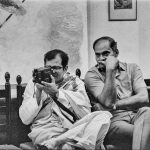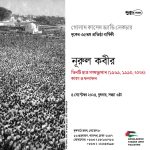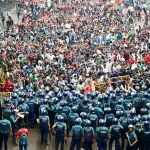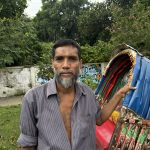

-
ROMEL CHAKMA II: Is custodial killing heroic?
by rahnuma ahmed Official versions conflict about why Romel Chakma…
-
সেনাবাহিনী বিষয়ে আমার বক্তব্য খন্ডিতভাবে প্রচার করে বিভ্রান্তির সুযোগ তৈরি করা হচ্ছে
সম্প্রতি বাংলাদেশ আওয়ামী লীগ তথ্য প্রযুক্তি বিষয়ক নির্বাচন পরিচালনা কমিটি…
-
DEATH OF ROMEL CHAKMA: NHRC seeks Army?s explanation
DEATH OF ROMEL CHAKMA NHRC seeks Army?s explanation Muktadir Rashid…
-
Moving opening ceremony of "Kalpana's Warriors"
Remarkable: Noam Chomsky Absolutely stunning: Jess Worth. New Internationalist Magazine…
-
Kalpana's Warriors
Remarkable: Noam Chomsky Absolutely stunning: Jess Worth. New Internationalist Magazine…
-
Deutsche Welle interviews Shahidul Alam on "Searching for Kalpana Chakma" show (Bangla)
Military’s sole role has been repression ???????? ??????????? ??????? ???…
-
YOUTH UPRISING AT SHAHBAGH
Reclaiming Ekattur: fashi, Bangali By Rahnuma Ahmed Prologue EVEN THOUGH…
-
Ramu violence: A fanoosh is not a balloon
by Pragyananda Bhikkhu Translated by Rahnuma Ahmed Translator’s note: Young…
-
-
CONCLUDING PART: Govt response to communal attack in Ramu
by?rahnuma ahmed In today’s column, I basically deal with three…
-
-
Beautiful Bangladesh
Subscribe to ShahidulNews Somewhat romanticised, particularly considering what?s been happening…
-
Kalpana's Family: Living Under State Surveillance
Subscribe to ShahidulNews by Saydia Gulrukh ?Do the words of…
-
Chittagong Hill Tracts and the Bengali sense of victimhood
By Rahnuma Ahmed A cartoon had caught my eye. Published…
-
-
Ethnically Singular Nationalist Narratives
`Warring factions’ in the CHT By Rahnuma Ahmed In homage…
-
-
Family secrets, state secrets
Subscribe to ShahidulNews Rahnuma Ahmed History is never more compelling…
-
Unidentified terrorists in the hills
Subscribe to ShahidulNews rahnuma ahmed Some external terrorists from outside…
-
Power of Culture: Bangladeshi Spirit
Subscribe to ShahidulNews Over the years, February has become our…
-
Latest Posts
Categories
- 1971
- Afghanistan
- Arts
- Bangladesh
- Capitalism
- Caretaker government
- Censorship
- China
- Chittagong Hill Tracts
- Chobi Mela
- Chobi Mela VII
- Coal
- Colonialism
- Consortium government
- Corruption
- COVID 19
- Crossfire
- culture
- Current News Photos
- Democracy
- development
- Disappearances
- disasters
- Drik and its initiatives
- Drik DNA
- Drik's Network Partners
- Drugs
- economy
- Education
- Elections
- Energy
- environment
- exploitation
- features
- Film
- Garments
- Gas
- Gender
- Genocide
- Global Issues
- Governance
- guimet
- Health
- History
- Human rights
- Humour
- Immigration
- Imperialism
- India
- Interesting sites
- Interviews
- Interviews and Features
- Islam
- Kalpana Chakma
- Killings
- Law
- lectures
- literature
- Major Features on Bangladesh
- Majority World
- media
- Media issues
- Migration
- Military
- mining
- Mir Jafar
- Monarchy
- Music
- My Photo Essays
- Nepal
- New Age
- New Media
- News Archives
- News Photo Archives
- Nuclear
- Occupation
- Oil
- Pakistan
- Partition
- Pathshala
- People
- Personal
- Photography
- Photojournalism
- Photojournalism issues
- photojournalist
- politics
- Poverty
- RAB
- Rahnuma Ahmed
- Religion
- Resistance
- Reviews
- Science
- security
- Shahidul Alam
- Sheikh Hasina
- short stories
- Sites of Drik and Pathshala photographers
- South Asia
- Southern Exposure
- Sports
- Sri Lanka
- surveillance
- Taliban
- Technology
- Terrorism
- Transport
- UK
- Uncategorized
- USA
- Violence
- War
- war on terror
- Water
- World
Tags
1971 Art Arts Bangladesh book censorship Chobi Mela Chobi Mela VII culture Death democracy Dhaka Drik education Elections exhibition Festival garments Gaza Genocide Governance history Human rights India Israel Journalism Law literature Majority World media Military Pakistan Palestine Pathshala Photography Photojournalism politics Rahnuma Ahmed resistance Shahidul Alam USA Violence Visual Arts War War Crimes



